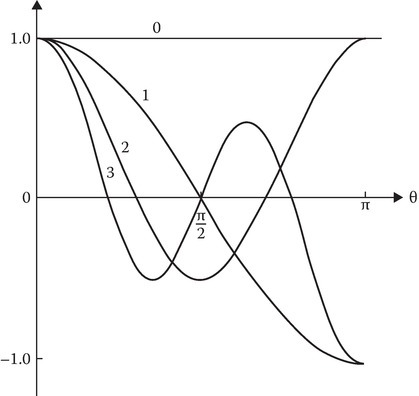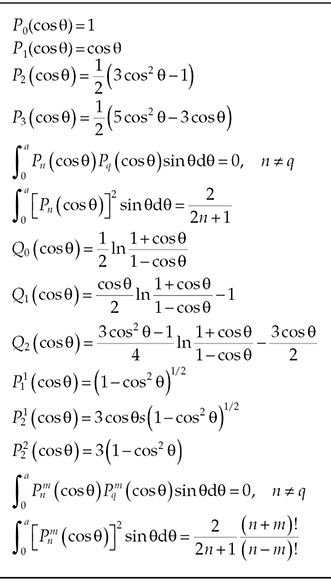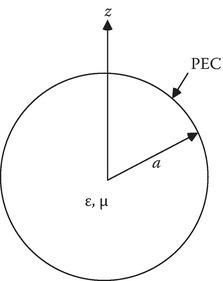]>
5
Spherical Waves and Applications
So far, we have discussed plane waves and cylindrical waves. In both of these cases, we could develop with relative ease the solutions based on TMz and TEz modes. We illustrated these solutions by solving some waveguides and cavity problems. The superscript z is added here to indicate that the transverse plane is perpendicular to the z-coordinates. The structures under consideration had a uniform cross section for all values of z. In spherical coordinates, we do not have any such transverse planes, and thus spherical wave problems are mathematically more involved. It is still possible to have mode classification as TMr and TEr.
The solution in spherical coordinates involves special functions: spherical Bessel functions and associated Legendre functions. Spherical Bessel functions are related to half-integral Bessel functions.
5.1Half-Integral Bessel Functions
In connection with the solution for a scalar Helmholtz equation in spherical coordinates, we come across the differential equation
which, when expanded, gives
By comparing with Equation 2.120, we immediately realize that f can be written as a linear combination of half-integral Bessel functions:
Half-integral Bessel functions can be shown to reduce to simpler forms:
In particular, we can show from Equation 5.4 that
From Equations 5.6 and 5.7, we can obtain the zeros of half-integral Bessel functions and their derivatives. These are listed in Tables 5.1 and 5.2.
TABLE 5.1
Zeros of Half-Integral Bessel Functions χn+1/2,I
| J1/2 | J3/2 | J5/2 |
|---|---|---|
| 3.1416 | 4.4934 | 5.7635 |
| 6.2832 | 7.7253 | 9.0950 |
TABLE 5.2
Zeros of Derivatives of Half-Integral Bessel Functions
| 1.1656 | 2.4605 | 3.6328 |
| 4.6042 | 6.0293 | 7.3670 |
5.2Solutions of Scalar Helmholtz Equation
The scalar Helmholtz equations
and
can be solved in spherical coordinates by the usual technique of separation of variables. Let
Substituting Equations 5.9 into 5.8 and manipulating the equation, we obtain the ordinary differential equations for f1, f2, and f3 involving two separation constants m and n:
By substituting
in Equation 5.10, we obtain Equation 5.2, with f thus given by a linear combination of half-integral Bessel functions given by Equation 5.3. The solution for f1 is given by
Defining the spherical Bessel function bn in terms of the half-integral Bessel functions Bn+1/2, we obtain
where
bn stands for any of the spherical Bessel functions jn, yn, , and
Bn+1/2 stands for the half–integral Bessel functions, Jn + 1/2, Yn+1/2, , and
Equation 5.11 is called the associate Legendre equation whose solutions are linear combinations of associate Legendre polynomials of the first kind and the second kind of degree n and order m. These polynomials are given by
Associated Legendre polynomials of zero order (m = 0) are called Legendre polynomials. In Equation 5.16, Equation 5.17, Equation 5.18 and Equation 5.19, x = cos θ. Note that the order m is an integer between 0 and n. Plots and expressions for a few Legendre polynomials are given in Figure 5.1 and Table 5.3. Note that on the polar axis, that is, θ = 0 or π, Qn → ∞. So, for the problem that includes a positive or negative polar axis in the field region, the function alone is the suitable solution. The solution for Equation 5.12 is a linear combination of cos mϕ and sin mϕ. Putting together the solutions for f1, f2, and f3, the solution for Equation 5.8 may be written as

FIGURE 5.1
Polynomials Pn(cos θ). The degree n is indicated on the graph.
TABLE 5.3
Legendre Functions

5.3Vector Helmholtz Equation
The electric and magnetic fields in a sourceless region satisfy the vector Helmholtz equations
Each Cartesian component of and satisfies the scalar Helmholtz equation (5.8), but the spherical components do not satisfy Equation 5.8.
It is convenient once more to think of simple solutions of these equations in terms of TEr, TMr, and TEMr modes in the context of spherical geometry.
5.4TMr Modes
These modes may be constructed by considering a vector field
where satisfies Equation 5.8. It can be shown that satisfies the vector Helmholtz equation. Identifying with and noting from Equation 5.23 that
we recognize all the above as the magnetic field components of TMr modes in terms of the electric Debye potential . The corresponding electric field components can be obtained from Maxwell’s equation
and are given as
5.5TEr Modes
These modes may be constructed by considering the vector function
where satisfies Equation 5.8. It can be shown that satisfies the vector Helmholtz equation. Identifying with the field and noting from Equation 5.31 that
we recognize the above as the electric field expressions of TEr modes. The corresponding magnetic field components can be obtained from Maxwell’s equation
and are given by
5.6Spherical Cavity
We illustrate the construction of solutions in spherical coordinates by determining the resonant frequencies of a spherical cavity with PEC boundary conditions at r = a (Figure 5.2).

FIGURE 5.2
Spherical cavity with PEC boundary.
For TM modes is given by Equation 5.20.
Since θ = 0 or π are part of the field region, we choose for θ variation. Since we need an oscillatory function that is finite at the origin, we choose jn(kr) for n variation.
The r variation of rFe is given by
To suit such applications as above, Schelkunoff defined another set of spherical Bessel functions:
The roots of are given in Table 5.4.
TABLE 5.4
Zeros of
| ζnp | n = 1 | n = 2 | n = 3 |
|---|---|---|---|
| p = 1 | 4.493 | 5.763 | 6.988 |
| p = 2 | 7.725 | 9.095 | 10.417 |
| p = 3 | 10.904 | 12.323 | 13.698 |
We may as well now list in Table 5.5 the roots of .
TABLE 5.5
Zeros of
| n = 1 | n = 2 | n = 3 | |
|---|---|---|---|
| p = 1 | 2.744 | 3.87 | 4.973 |
| p = 2 | 6.117 | 7.443 | 8.722 |
| p = 3 | 9.317 | 10.713 | 12.064 |
The PEC boundary conditions are at r = a, which leads to the boundary condition
Note that n cannot be zero since
And from Equations 5.29 and 5.30, and are zero not only on the boundary but also everywhere inside the cavity. Thus, n = 0 gives a trivial solution. The lowest resonant frequency of TM modes is given by
Let us next consider the TEr modes. The boundary conditions in this case, from Equations 5.33 and 5.34, are
which translate to
The lowest value of the above occurs when n = 1 and p = 1,
The lowest resonant frequency of all the modes is thus given by Equation 5.45. The modes in a spherical cavity are highly degenerate, that is, for the same resonant frequency we can have many different field distributions.
